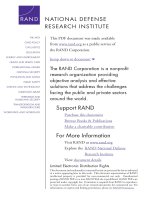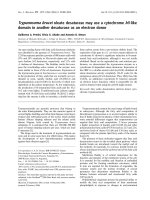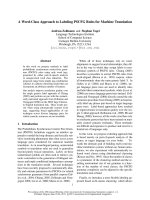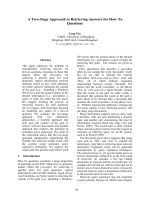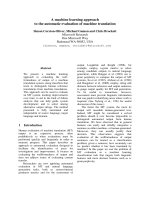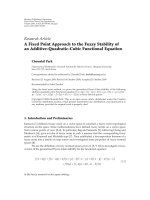A Strategic Planning Approach - Defining Alternative Counterterrorism Strategies as an Illustration pot
Bạn đang xem bản rút gọn của tài liệu. Xem và tải ngay bản đầy đủ của tài liệu tại đây (355.75 KB, 51 trang )
This document and trademark(s) contained herein are protected by law as indicated in a notice appearing later in
this work. This electronic representation of RAND intellectual property is provided for non-commercial use only.
Unauthorized posting of RAND PDFs to a non-RAND Web site is prohibited. RAND PDFs are protected under
copyright law. Permission is required from RAND to reproduce, or reuse in another form, any of our research
documents for commercial use. For information on reprint and linking permissions, please see RAND Permissions.
Limited Electronic Distribution Rights
This PDF document was made available from www.rand.org as a public
service of the RAND Corporation.
6
Jump down to document
THE ARTS
CHILD POLICY
CIVIL JUSTICE
EDUCATION
ENERGY AND ENVIRONMENT
HEALTH AND HEALTH CARE
INTERNATIONAL AFFAIRS
NATIONAL SECURITY
POPULATION AND AGING
PUBLIC SAFETY
SCIENCE AND TECHNOLOGY
SUBSTANCE ABUSE
TERRORISM AND
HOMELAND SECURITY
TRANSPORTATION AND
INFRASTRUCTURE
WORKFORCE AND WORKPLACE
The RAND Corporation is a nonprofit research
organization providing objective analysis and effective
solutions that address the challenges facing the public
and private sectors around the world.
Visit RAND at www.rand.org
Explore RAND-Initated Research
View document details
For More Information
Purchase this document
Browse Books & Publications
Make a charitable contribution
Support RAND
RAND-INITIATED RESEARCH
This product is part of the RAND Corporation occasional paper series. RAND
occasional papers may include an informed perspective on a timely policy issue, a
discussion of new research methodologies, essays, a paper presented at a conference, a
conference summary, or a summary of work in progress. All RAND occasional papers
undergo rigorous peer review to ensure that they meet high standards for research
quality and objectivity.
C O R P O R A T I O N
A Strategic Planning
Approach
Defining Alternative
Counterterrorism Strategies
as an Illustration
Lynn E. Davis, Melanie W. Sisson
The RAND Corporation is a nonprofit research organization providing objective analysis
and effective solutions that address the challenges facing the public and private sectors
around the world. RAND’s publications do not necessarily reflect the opinions of its
research clients and sponsors.
R
®
is a registered trademark.
© Copyright 2009 RAND Corporation
All rights reserved. No part of this book may be reproduced in any form by any electronic or
mechanical means (including photocopying, recording, or information storage and retrieval)
without permission in writing from RAND.
Published 2009 by the RAND Corporation
1776 Main Street, P.O. Box 2138, Santa Monica, CA 90407-2138
1200 South Hayes Street, Arlington, VA 22202-5050
4570 Fifth Avenue, Suite 600, Pittsburgh, PA 15213-2665
RAND URL:
To order RAND documents or to obtain additional information, contact
Distribution Services: Telephone: (310) 451-7002;
Fax: (310) 451-6915; Email:
This Occasional Paper results from the RAND Corporation's continuing program of
self-initiated research. Support for such research is provided, in part, by the generosity of
RAND's donors and by the fees earned on client-funded research.
Library of Congress Cataloging-in-Publication Data is available for this publication.
iii
Preface
is occasional paper defines an approach to strategic planning and then illustrates how one
might implement the approach to define alternative counterterrorism strategies, using RAND
researchers and research as a resource. It should be of interest to those in the incoming admin-
istration as well as throughout the U.S. government interested in doing strategic planning. e
paper is also a resource for those involved in defining U.S. counterterrorism strategies inside
and outside the U.S. government. is research in the public interest was undertaken by the
RAND Corporation using flexible internal research funds.
v
Contents
Preface iii
Figures
vii
Tables
ix
Summary
xi
Acknowledgments
xv
Abbreviations
xvii
CHAPTER ONE
Introduction 1
Background
1
Objective
2
Organization of is Document
3
CHAPTER TWO
Defining an Approach to Strategic Planning 5
Current U.S. Approach to Planning
5
An Approach to Strategic Planning
6
CHAPTER THREE
Implementing Our Strategic Planning Approach: Defining Alternative Counterterrorism
Strategies
9
Step 1: Define Strategic Goal
9
Step 2: Define Different “Means” to Achieve Strategic Goal
10
Step 3: Define Alternative Counterterrorism Strategies with Means Prioritized
12
Counterterrorism Strategy 1
14
Counterterrorism Strategy 2
18
Counterterrorism Strategy 3
21
Step 4: Facilitate Choice of a Strategy
24
Choosing Among the Counterterrorism Strategy Approaches
24
Steps to Take Once a Strategy Approach Is Chosen
25
CHAPTER FOUR
Implementing the Strategic Planning Approach Within the U.S. Government 27
Bibliography
29
RAND Research Used in the Counterterrorism Illustration
29
Other References
31
vii
Figures
S.1. Our Strategic Planning Approach xii
2.1. Conceptual View of Current U.S. Approach to Planning
5
2.2. Conceptual View of Government Strategic Planning Approach
6
2.3. Our Strategic Planning Approach
7
ix
Tables
S.1. Components of Counterterrorism Strategies xiii
1.1. Examples of Past Strategic Planning
2
3.1. Expert Opinions on Which “Means” Should Be Prioritized
13
3.2. Components of Counterterrorism Strategy 1
14
3.3. State Department Budget, FY 2009 Budget Request
16
3.4. Components of Counterterrorism Strategy 2
18
3.5. State Department Budget, FY 2009 Budget Request
20
3.6. Components of Counterterrorism Strategy 3
22
xi
Summary
The Need for Strategic Planning
While the U.S. government has historically undertaken strategic reviews and produced numer-
ous strategy documents, these have provided only very general directions for U.S. policymak-
ers. ey do not represent what might be called strategic planning: the definition of a strategy
in which the means are prioritized to achieve an operationally defined strategic goal.
Many would argue that the setting of priorities is impossible given the complexity of the
world. Priorities can also limit the flexibility government departments claim they need to be
able to carry out their missions. ere is also widespread appreciation of the difficulty of set-
ting priorities within the decentralized U.S. policymaking process. Others, however, do see a
need for setting priorities. One reason would be to increase the effectiveness of one’s policies in
achieving strategic goals. Priorities would also make it possible to allocate limited government
resources and provide a compelling foundation for seeking public and congressional support
for particular programs. Better efficiencies in government activities could also be achieved by
establishing priorities, and priorities could help achieve coherence in the government’s overall
activities and operations.
e purpose of this study is to define an approach to strategic planning for consider-
ation by the U.S. government and to illustrate its application using the example of the critical
national security topic of counterterrorism. To do this, we drew on more than twenty RAND
research reports and on numerous RAND experts. It is important to note that this exercise
is intended to be purely illustrative: We are not advocating any specific roadmap, operational
plan, or bureaucratic solution to the counterterrorism challenges discussed here.
An Approach to Strategic Planning
Our strategic planning approach has four steps as shown in Figure S.1. e approach aims to
systematically define alternative strategies and to suggest how one might go about choosing
one of the strategies, i.e., the considerations that could lead to the adoption of one strategy
rather than another.
xii A Strategic Planning Approach: Defining Alternative Counterterrorism Strategies as an Illustration
Figure S.1
Our Strategic Planning Approach
RAND OP242-S.1
Define different
“means” to
achieve
strategic goal
Define alternative
strategies with
“means”
prioritized
Facilitate choice
of strategy
Define
strategic goal
Step 1
Step 3
Step 2
Step 4
IIllustrating the Approach: Alternative Counterterrorism Strategies
In our illustrative case, counterterrorism, we defined the strategic goal (Step 1) as:
Prevent attacks by al Qaeda and other Salafi-jihadist groups from occurring within
the United States that are psychologically significant (i.e., attacks involving tens of
casualties or smaller frequent attacks).
We next defined the full range of available means, or policy tools, making them as spe-
cific and distinct as possible (Step 2). We then asked RAND experts for their views on which
of the “means” should be given priority and why. ese views tended to diverge based on the
experts’ assessments of the primary requirement for al Qaeda to be able successfully to attack
the U.S. homeland.
Based on these varying assessments, we defined three alternative counterterrorism strat-
egy approaches, and then selected the means to carry them out, differentiating those that
were “core” priority means and those that could be added, depending on how one views their
potential effectiveness in achieving the strategic goal (Step 3). e strategies are summarized
in Table S.2.
e final step in our approach to strategic planning is to set the stage for policymakers to
choose among the alternative strategy approaches. For counterterrorism, we outlined a number
of considerations that could be used to guide this choice. One is whether one of the assessments
of what al Qaeda needs to carry out psychologically significant attacks in the United States is
correct in its identification of the primary requirement, and if so, the choice of that strategy
approach would follow. Another consideration is how well the strategy approaches measure up
to what we know about al Qaeda’s history of operations and what has worked or not worked
in terms of U.S. actions. Yet another consideration is whether al Qaeda currently has, or in the
near future will have, the capabilities that match the primary requirement identified in each
Summary xiii
strategy. A final consideration is how well the United States could be expected to implement
the strategy approach.
If a strategy approach is chosen, then steps would be needed to implement the strategy,
including decisions about exactly what the prioritized means will comprise, what programs
will be employed, what funds will be allocated, and how the counterterrorism strategy will be
integrated with other U.S. national security policies.
Implementing the Strategic Planning Approach Within the U.S. Government
How might our strategic planning approach be implemented within the U.S. government
national security policymaking process? In real-world policymaking, the intellectual steps in
our strategic planning approach would need to be undertaken in a very different environment
from that at RAND: one where officials from many departments and agencies bring expertise
as well as strong bureaucratic interests, where decisionmaking responsibility is highly decen-
tralized, and where resistance exists not only to making choices but also to making changes in
existing policies.
Implementing our strategic planning approach inside the U.S. government will, there-
fore, require a top-down decisionmaking process, orchestrated by the Assistant to the President
for National Security Affairs, on behalf of the President, and with the personal engagement of
the department secretaries and agency heads. e choice of a strategy would be informed by a
background paper that would flesh out each of the steps in our strategic planning approach for
the chosen national security topic. e key step is defining the alternative strategies. ese need
to be analytically derived, based on assessments of the factors that might threaten achievement
of the strategic goal. e strategies should not be bureaucratically driven and they should not,
as is often the case in the government, represent a single bureaucratic-consensus option and a
number of “straw man” alternatives.
Table S.1
Components of Counterterrorism Strategies
Components Strategy 1 Strategy 2 Strategy 3
Assessment of what
al Qaeda needs to be able
to inflict psychologically
significant attacks in the
United States
Maintain active network
of individuals and groups
with access to resources
and communications
Secure territory and
establish a base to plan,
train, and acquire resources
Motivate leaders and
recruits to undertake
violent attacks
Overall strategy approach Disrupt violent jihadist
groups’ activities through
counterterrorism opera-
tions
Deny jihadist groups safe
havens and resources
Reduce influence of
purveyors of jihadist ideas
Core priority means Assist friendly govern-
ments in their ability to
operate on their own
against violent jihadist
groups
Assist states in extending
governance, infrastructure,
and security throughout
their territories
Exploit weakened
theological justification
for violence; disrupt and
capture motivational
leaders; encourage
defections from jihadist
groups
Other possible priority
means
Provide U.S. operational
assistance; capture or kill
highly skilled operational
leaders
Seek to deny money,
recruits, and conventional
weapons to jihadist
groups in countries with
ungoverned territories
Break up cooperation
between al Qaeda and local
jihadist groups
xiv A Strategic Planning Approach: Defining Alternative Counterterrorism Strategies as an Illustration
In the end, even if a single strategy with prioritized means is not chosen, going through
the steps in our strategic planning approach has advantages. It can help clarify what one aims
to achieve for the specific national security policy topic, uncover underlying assumptions, and
illuminate the critical and contentious issues. Most importantly, it would mean a decision to
pursue all means without any prioritization was undertaken not by default but, rather, con-
sciously, because it was identified as being the best available course of action.
xv
Acknowledgments
is Occasional Paper benefited from the support and assistance of many RAND researchers.
In illustrating our approach to strategic planning, we enlisted counterterrorism experts across
RAND and drew on their analyses that spanned the multiple ways the nation is confronting
the threat posed by violent jihadists. Our thanks go to each of these experts for their time and
insights, and their many analyses that we drew upon are noted in the report. Paul Steinberg
was a tremendous resource in helping us organize this paper and in clarifying our thinking and
presentation. We want also to thank C. Ryan Henry for his careful and thorough review of our
report. We also appreciated the support Dick Neu gave to our effort along the way, offering his
insights on the motivations of terrorists and where priorities in our policies need to be focused.
Finally, we wish to thank all those who supported the publication of the paper, and especially
Steve Kistler, our editor. e content and conclusions of the paper, however, remain solely the
responsibility of the authors.
xvii
Abbreviations
DoD Department of Defense
FMF Foreign Military Financing (U.S. State
Department program)
FY fiscal year
IMET International Military Education and
Training (U.S. State Department program)
MANPADS man-portable air-defense system
NSC National Security Council
WMD weapons of mass destruction
